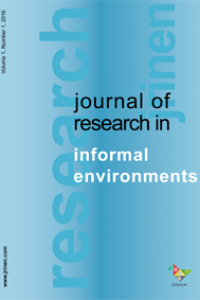Öz
Projemiz İzmir İl Milli Eğitim Müdürlüğü ve Matematiksel Güç ve
İnovatif Tasarım Derneği İşbirliği ile İzmir Kız Lisesi’nde
gerçekleştirilmiştir. Kasım ve Nisan ayları arasında 6 ay süresince da 9. Ve
10. Sınıfta okuyan 78 öğrencimiz, gruplar oluşturarak belirledikleri proje
konuları ile okul dışına çıkmışlardır. Öğrencilerimiz bu çalışma süresince okul
dışındaki dünyada gerçek yaşam problemleri belirlemiş ve matematiksel modelleme
yeterliklerini de kullanarak bu problemleri çözebilmişlerdir. Ayrıca
öğrencilerimiz sonraki yıllarda kullanılabilecek ve geliştirilebilecek şekilde İzmir
İli “Matematik Rotası” nı ve buna bağlı
olarak Mobil “Matematik Şehir Haritasını” oluşturabilmişlerdir.
Öğrencilerimizin hem grup bazında hem de bireysel olarak bazı önemli
yeterlik düzeylerinin süreçte geliştirdikleri gözlemlenmiştir.
Çalışmamız sonuçlarından biri “Matematik Rotası” nın, matematiksel
modelleme ile matematiğin gerçek yaşamdaki üstlendiği rolü anlamalarını ve
değer vermelerini sağlayan yardımcı bir araç olabileceğidir. Bir diğeri ise bu
tür rotaların STEM Eğitimi yaklaşımı ile daha da zenginleşen bir eğitim ortamı
oluşturacak nitelikte olduğudur.
STEM Eğitimi yaklaşımını ile daha iyi bir eğitim ortamı sağlayabilmek
adına 2016 yılı içinde CASIO firmasının da desteği almamız sonucunda olduğumuz
“Mobil Laboratuvar” ile de yukarıdaki projemizi birleştirme şansını yakalamış
olduk. Kâğıt-kalem, Grafik Tabanlı Hesap
Makinesi ve Data-Logger üçlüsünün kullanımı sayesinde mini mühendislik
problemlerimizde artık Mobil Matematik Şehir Haritamız üzerine işlenebilir hale
gelmiştir.
Anahtar Kelimeler
Matematik Rotası Dışarıda Matematik Gerçek Yaşam Matematik Şehir Haritası MathCityMap Grafik Tabanlı Hesap Makinesi Data-Logger STEM Eğitimi MAGİT Derneği
Kaynakça
- Altun, M.:1998 , Matematik Öğrenme ve Öğretme Süreci. Matematik Öğretimi Editör: Ankara A. (Eds.), Anadolu Üniversitesi Yayınları,1998.Yayın no: 1072, 26-52. Alındığı tarih: 15.10.2013, adres: http://w2.anadolu.edu.tr/aos/kitap/IOLTP/2289/unite02.pdf
- Berry J ve Houston K.: 1995, Mathematical modelling. Edward Arnold, London.
- Blum, W. ve Leiß, D.: 2007a, How do students and teachers deal with modelling problems? In C. Haines et al. (Eds), Mathematical Modelling. Education, Engineering and Economics. Chichester: Horwood , 222-231.
- Blum, W. et al.: 2002, ICMI Study 14: Application and modelling in mathematics education – Disscussion document. Educational Studies in Matematics 51(1-2), 149-171.
- Borromeo Ferri, R.: 2006, Theoretical and empirical differentiations of phases in the modelling process. In Zentralblatt für Didaktik der Mathematik, 38 (2) 86-95.
- Ludwig, M., ve Xu, B.: 2010, A Comparative Study of Modelling Competencies among Chinese and German Students. Journal for didactics of Mathematics. Vol. 31, pp: 77–97.
- Ludwig, M., Jesberg, J. ve Weiss, D.: 2013, Frankfurt MathCityMap - ein Smartphone-Projekt um Mathematik draußen zu machen. Beiträge zum Mathematikunterricht 2013 Digital Vol. 2, pp: 622–635. Alındığı tarih: 14.10.2013, adres: http://www.mathematik.uni-dortmund.de/ieem/bzmu2013.
Öz
Our Project was carried out by
the Izmir Provincial Directorate of National Education, Mathematical Power and
Innovative Design Association and the Izmir High School for Girls at Izmir
between November and April. 78 9th &
10th grade students were assigned to groups and required to determine their
out-of-school project topics. At the end of the study, they identified real
world problems and were able to solve these problems by using their
mathematical modeling skills. Moreover, they created the Izmir Provincial
“Mathematics Route” which can be used and improved in the future.
One of our results of this
study is that the “Mathematics Route” can be a helpful tool to understand the role of mathematics and mathematical
modeling in real life and appreciate them. Another result of the study, these
routes can provide an enriched educational environment with the STEM approach.
We developed one of our
national routes by processing these problems that identified by our students
into International Mobile Map of Goethe University in Germany and had Izmir
Provincial “Mathematics City Map” operationalized. All the problems identified
by our students are now available to all secondary school students in Izmir
Province.
In addition, the data we
obtained from this study were used in our teacher workshops between 2015-2016
academic years. Other participant schools that were interested in this project
have begun to work on their own “Mathematics Routes”.
In this study, we categorized
every step of students’ thoughts during the identification process of the
problems based on the proficiency levels in our Mathematical Modeling cycle.
When we compare the pre- and post-
assessments, we found that some of our students improved their proficiency both individually and as a group during this
process..
Students’ active participation
and positive feedback during their engagement with the activities demonstrated
that the “Mathematics Route” could be integrated to mathematics courses from
elementary to high school.
Anahtar Kelimeler
Mathematics Route Mathematics Outside Real Life Mathematics City Map Graph-Based Calculator Data-Logger STEM Training MAGIT Association
Kaynakça
- Altun, M.:1998 , Matematik Öğrenme ve Öğretme Süreci. Matematik Öğretimi Editör: Ankara A. (Eds.), Anadolu Üniversitesi Yayınları,1998.Yayın no: 1072, 26-52. Alındığı tarih: 15.10.2013, adres: http://w2.anadolu.edu.tr/aos/kitap/IOLTP/2289/unite02.pdf
- Berry J ve Houston K.: 1995, Mathematical modelling. Edward Arnold, London.
- Blum, W. ve Leiß, D.: 2007a, How do students and teachers deal with modelling problems? In C. Haines et al. (Eds), Mathematical Modelling. Education, Engineering and Economics. Chichester: Horwood , 222-231.
- Blum, W. et al.: 2002, ICMI Study 14: Application and modelling in mathematics education – Disscussion document. Educational Studies in Matematics 51(1-2), 149-171.
- Borromeo Ferri, R.: 2006, Theoretical and empirical differentiations of phases in the modelling process. In Zentralblatt für Didaktik der Mathematik, 38 (2) 86-95.
- Ludwig, M., ve Xu, B.: 2010, A Comparative Study of Modelling Competencies among Chinese and German Students. Journal for didactics of Mathematics. Vol. 31, pp: 77–97.
- Ludwig, M., Jesberg, J. ve Weiss, D.: 2013, Frankfurt MathCityMap - ein Smartphone-Projekt um Mathematik draußen zu machen. Beiträge zum Mathematikunterricht 2013 Digital Vol. 2, pp: 622–635. Alındığı tarih: 14.10.2013, adres: http://www.mathematik.uni-dortmund.de/ieem/bzmu2013.
Ayrıntılar
| Konular | Eğitim Üzerine Çalışmalar |
|---|---|
| Bölüm | Makaleler |
| Yazarlar | |
| Yayımlanma Tarihi | 30 Haziran 2017 |
| Yayımlandığı Sayı | Yıl 2017 Cilt: 2 Sayı: 1 |


